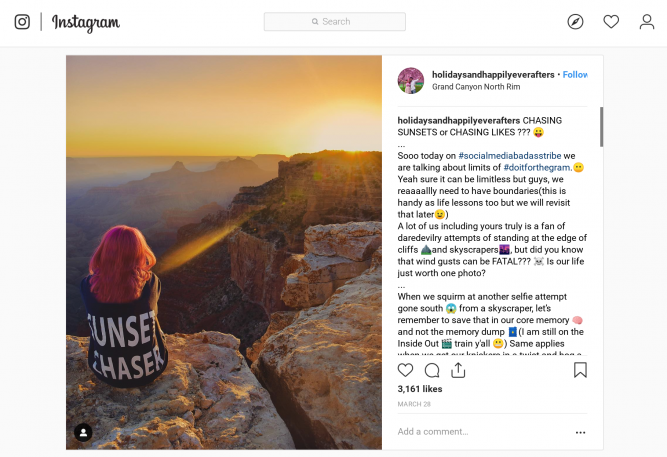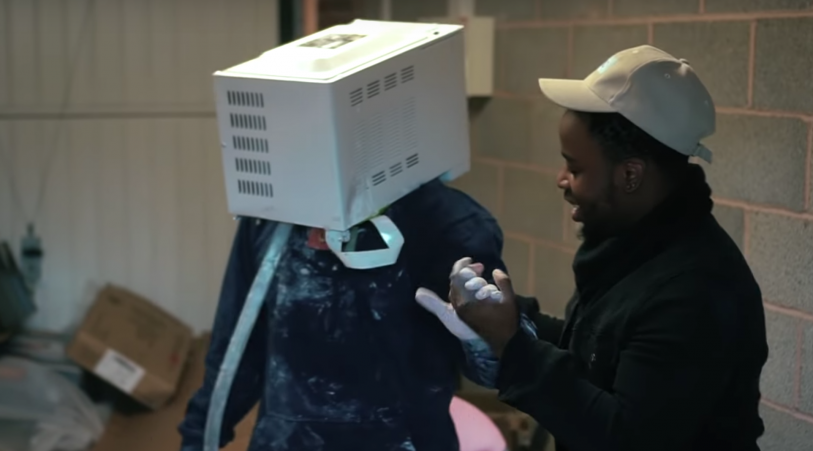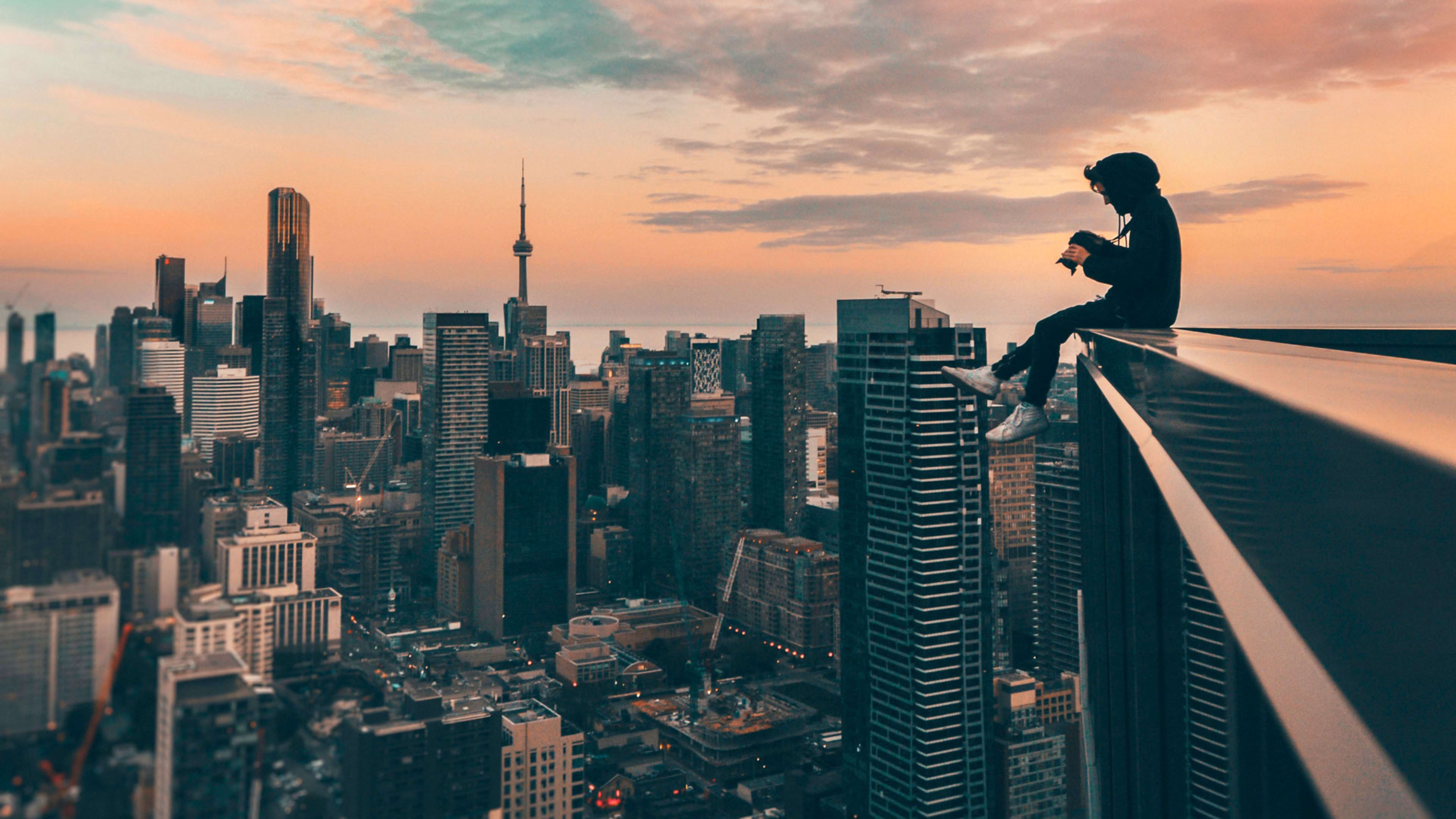“Is our life just worth one photo?”
The question was posted in March on an Instagram account shared by a young couple named Vishnu and Meenakshi Moorthy, two software engineers and travel bloggers from India who had been living and working in Silicon Valley.

The post showed Meenakshi sitting on the edge of a rock over the Grand Canyon with the caption, in part: “A lot of us including yours truly is a fan of daredevilry attempts of standing at the edge of cliffs and skyscrapers . . . Is our life just worth one photo?”
In October, they were killed by an 800-foot fall at Yosemite National Park, an accident that occurred while they were on the edge of a cliff and probably taking pictures for Instagram.
The Moorthys’ fairy-tale life ended tragically. But their story is part of a growing and dangerous trend in the global contest for social media fame.
A subculture has emerged in the past eight years of people who seek out death-defying situations–and they do it for the likes, followers, and adulation of fans on social media.
How it all began
In 2011, a Canadian named Tom Ryaboi dangled his feet over the edge of a tall building in Toronto and took a picture straight down. He posted it on Flickr, Reddit, and 500px. The picture was a viral hit.
Ryaboi titled his image, “I’ll make you famous.” But the picture made him famous–and also helped to spread the phenomenon of “rooftopping,” in which people climb as high as they can on a building or tower.
Rooftopping had existed for years as an obscure branch of urban hacking. But the social internet transformed these pursuits from private thrill seeking into a genre of public photography and video. The adrenaline rush was still part of the idea. But so were the clicks, likes, subscribers, and even income.
With “I’ll make you famous,” a new kind of social media star was born: the social media daredevil. In 2014, Vitaliy Raskalov and Vadim Makhorov climbed the Shanghai Tower. Their GoPro video of the stunt now has more than 73 million views.
After that event, a new generation of Instagrammers, YouTubers, and members of other social networks began to cultivate the craft of risking life and limb to post heart-pounding pictures and videos of dangerous stunts. Risk-taking social media photography deaths and injuries roughly tripled in number from the beginning of 2014 to the end of 2015, according to media analysis conducted by researchers in Turkey.
The stunts take many forms: posing on tall buildings or high cliffs; reckless activity on, in, near, or under trains, cars, or motorcycles; interaction with wild animals; all manner of dangerous jackassery (you know, for the LOLs); extreme eating; and more.
It’s easy to dismiss the trend as the folly of reckless youth. But some of the images are breathtakingly beautiful. The photographs and videos on Russian model Angela Nikolau’s Instagram feed, for example are stunning in part because of the danger.
Like Nikolau, many of these social media risk-takers are practiced and skillful.
Some of their imitators–not so much.
Rising fatalities
A study published in the Journal of Family Medicine and Primary Care found that some 259 people died taking selfies between October 2011 and November 2017.
Journalists have covered this report extensively. But the number can mislead.
As psychologist and author Tracy P. Alloway told me, many of those included in that figure weren’t habitual social media risk takers or rising social media stars, but regular people who happened to be killed while taking selfies during unusual circumstances.
Wikipedia actually keeps a list of people killed or nearly killed while trying to take selfies. Most of these deaths were not habitual social media risk takers.
For example, a man named Prabhu Bhatara was returning home from a wedding in the Indian state of Odisha when he spotted a bear. Against the advice of his friends, he decided to take a selfie with the animal in the background. Tragically, he was mauled to death by the bear, which added a number to the statics around “selfie deaths.” But Bhatara was not a social media thrill seeker, just an ordinary person who made an unfortunate choice.
It’s also true that many people who do engage in frequent risk taking for social media aren’t taking selfies–they’re the models if you will, photographed by others–and as such, fatalities in this category aren’t counted as “selfie deaths.”
And finally, the number counted in the death-by-selfie study was based on media reports. Some selfie-related deaths go unreported.
The bottom line is that we don’t really know how many people have died in recent years due to the risk-taking social trend, just that fatalities and injuries are on the rise. Still, the selfie-death studies are a reasonable proxy for the trend and our best source of hard data.
The leading cause of death while taking selfies is drowning, followed by transportation (trains and cars), and then falling from high places.
Social media risk-taking culture varies by nation. More than half of all global selfie deaths happen in India. (The top four nations for selfie deaths, according to the report are, in order: India, Russia, the United States, and Pakistan.) The majority of Indians who die while trying to capture photos for social do so by falling off high places. Many other such deaths involve “train surfing” (a phenomenon so big in India that National Geographic covered it).
In the U.S., as one might predict, the majority of such deaths are by firearms. A video news report posted on YouTube recently showed a man at a gun range pointing his gun at a friend for a selfie before a range safety officer skillfully intervened.
YouTube and some other social sites have witnessed wave after wave of dangerous “challenges” since 2014, including the “Fire Challenge” (where people set themselves on fire), the “Tide Pod Challenge,” and others. These “challenges” are clearly driven by social media imitation and competition.
Other social media-driven stunts include dangerous driving or riding a bike or motorcycle; climbing on or touching power lines; posing on railroad tracks; posing with guns, grenades, or other weapons; and posing on beaches or on rocks with large waves.
Some of those killed had large social followings: Popular rooftoppers Wu Yongning and Andrey Retrovsky, for example, all had big followings and died in the pursuit of risk taking for social fame. So did YouTube stars Ryker Gamble, Alexey Lyakh, and Megan Scraper, who were participants in a popular gonzo travel YouTube channel and Instagram account called High On Life.
The channel features a lot of relatively safe leisure activities in exotic locations, but also risky stunts such as diving off rooftops into swimming pools, kayaking down sewage drains, and alligator wrestling. The trio was killed after Scraper slipped off a waterfall and fell into a dangerous pool below in British Columbia. Gamble and Lyakh died trying to save her.
Canadian rapper Jon James, who performed risky stunts in his music videos–essentially integrating the social media risk-taker subculture into his performances–fell to his death in October during a video shoot on an airplane wing.
While social media stars sometimes die in the act, it’s possible that the larger problem is the audience that copies what they see on social networks.
George Kourounis, an extreme weather “chaser” and presenter on the TV series Angry Planet, knows a thing or two about risking life and limb for video. His Twitter profile picture is a selfie he took in front of some extremely dangerous lava.
The selfie was shot inside Marum Crater on Ambrym Island in Vanuatu. The spot was so hot that without his protective suit, he would have survived there only a few seconds. And it partly melted the outside of his video camera. Kourounis told me that fans try to copy some of his exploits. He says he can’t stop people from doing that, but hopes they take safety as seriously as he does.
Volcano #selfie. When normal selfies are not extreme enough! pic.twitter.com/hSRWPDjfDX
— George Kourounis (@georgekourounis) August 28, 2014
Life-threatening stunts are obviously reckless and dangerous. But there’s another big problem.
Danger works
A British YouTuber named Jay Swingler performed a dangerous stunt about a year ago. He placed a plastic bag with a breathing tube over his head, then “glued” his head to the inside of a microwave oven with expanding plaster. The plaster set, and Swingler couldn’t get his head out of the microwave. It took a team of paramedics to set him free.
Dumb, right? But Swingler was rewarded with 70,000 new subscribers over the next three days after posting. Today, the video has more than 5.7 million views, and Swingler’s channel “TGFbro” enjoys 4.5 million subscribers. He now monetizes his YouTube channel in part with merchandise, including hats and hoodies that say “Childish.”

Ricky D. Crano, a lecturer in the department of English at Tufts University, told me that dangerous images posted on social media represent “a clear-cut case of market forces driving high-risk selfie publicity, a quintessential model of personhood for the digital age: the individual as entrepreneur of one’s self.”
Risk taking becomes part of one’s personal brand. “We must compete with others just to be seen–that is, for the algorithm to favor our post,” says Crano.
But the rewards are also internal. Psychologist Alloway told me that the driving forces for the posting of images showing the self in danger may be identical to other social media actions, such as addictive posting, constant selfie taking, and others. People post danger images because of narcissism and identity. Narcissists, for example, may feel “immune to the laws of nature,” according to Alloway.
Danger posts offer a double dose of dopamine–a reward for the risk taking, then another reward for the social rewards of likes, clicks, subscriptions, and followers.
Steve Stewart-Williams, author of the book The Ape That Understood the Universe, agrees that the motivations are pretty banal. People like to show off and fit in, and some crave an adrenaline rush.
Deliberate risk taking for an audience may be rooted in our evolutionary past, according to Stewart-Williams. “On average, men engage in more risky behavior–more showing off–than women, especially in early adulthood,” he says. “This is common in species where the maximum number of offspring for males is higher than that for females.” In prehistoric human societies, “The men who had the most offspring were those who took greater risks in the pursuit of status and prestige”–the Paleolithic equivalent of followers and likes.
The backlash arrives
Police in some locations are cracking down on risky photography for public safety. Ryaboi told me that Hong Kong in particular has become more strict.
Ryaboi himself was arrested in 2015 during a rooftopping jaunt in Toronto. He said that police tried to make an example of him by publicizing his arrest, but that it only made rooftopping more popular in Canada. Police dropped the charges.
The Indian state of Goa and other locations are establishing signed “no selfie zones,” but their effectiveness is questionable. And the Russian Interior Ministry has even produced a leaflet and PSA video and website warning about the danger of risky social media photography and videography. “A cool selfie could cost you your life,” it says, along with a host of stick-figure examples of how someone might die while trying to capture a thrilling selfie.
Some thrill-seeking social starts have been jailed or fined. One Russian Instagrammer and YouTuber uses the nom de stunt Kobzarro and wears a mask to conceal her identity. She says she started train surfing at the age of 15.
Is social networking to blame?
Stewart-Williams says that social media amplifies ordinary social competition, which can drive people to extremes. “Instead of just competing with the people around you, you’re potentially competing with anyone anywhere in the world,” he says. Worse, “the videos that go viral are the ones that are most extreme, so you’re competing with the most extreme risk takers on the planet.”
Crano says that “these incentives to ‘win’ at social media are a product of design and not an accident of social media platforms like Facebook, Instagram, and Twitter.” The incentives are “baked right in” and “essential to their corporate revenue generation.”
“The case for corporate responsibility here is a strong one,” he adds. But it’s “easy to refute such claims with counterclaims prioritizing shareholder responsibility.”
A Google spokesperson who works on YouTube policy told me that YouTube maintains policies against the depiction of harmful activities on the site. Google considers whether the people taking risks are trained or professional and are taking precautions, whether the act can be easily copied by minors, and whether the videos are educational, documentary, scientific, or artistic in nature.
For example, YouTube might delete content showing someone pointing a loaded gun at someone else while taking a selfie. But it would allow a TV news report that included the same video (as per my example above).
Google develops its policies in consultation with psychologists, pediatricians, emergency room doctors, and others.
Similarly, Twitter prohibits self-harm or encouraging others to hurt themselves. Dangerous “challenges” such as the “Tide Pod Challenge” are against Twitter’s rules. The company requires such tweets to be deleted; after repeated violations, it will suspend accounts. A Twitter spokesperson told me that Twitter’s policies are constantly changing as user behavior change and trends emerge.
Facebook, which owns Instagram, did not respond to my requests for an interview.
Hemank Lamba, one of the researchers on a project involving one American and two Indian universities, called, “From Camera to Deathbed: Understanding Dangerous Selfies on Social Media,” told me that the best solution is to increase awareness about the risks.
Technology can help. “We are experimenting with technology-based interventions” that use a camera feed to identify when the user is in danger, such as at a higher elevation or close to an approaching vehicle,” he says. The technology uses deep learning to identify pictures that depict life-threatening situations.
It’s easy to imagine that social sites like Twitter, Facebook, or Instagram might some day use technology like this to flag photos and videos that are taken in life-threatening situations. In the meantime, risk taking for social media fame is getting more extreme, and the number of fatalities seem to be on the rise. As the public slowly begins to understand the potential harm of social media–the addiction, the loss of time, the risk of depression–our best hope is that it also takes notice of the physical danger it can engender.
Recognize your brand’s excellence by applying to this year’s Brands That Matter Awards before the early-rate deadline, May 3.
